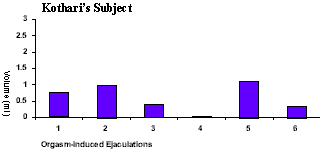|
|
 |
|

The Unprecedented Research Study from Rutgers University
|
| Summary of All Previous Studies |
| |
"Although there have been reports of multiple orgasms in males, there is some question as to whether or not they are complete orgasms or a resumption of an interrupted orgasm just before the 'Moment of Inevitability.'"
- "Encyclopedia of Sex", Westheimer, R., 1994, p. 194
Dr. Westheimer is correct to question the validity of reported "multiple orgasms in males" prior to this Rutgers Study. As unanimously concluded by all previous research studies, "complete orgasms" were not experienced by any of the males therein.
Prior to this 1995 Rutgers study, only five previous scientific studies had ever been conducted on male "multiple orgasm." None of these studies documented or claimed to document natural male multiple orgasm. In each case, ejaculatory control techniques were used to keep the Male Refractory Period (MRP) from occurring.
Only the Rutgers study succeeded in documenting a male sexual response cycle that did not include MRP after natural, fully ejaculatory orgasms.
The following provides a brief summary of the circumstances and findings of each of the previous studies:
Kinsey (1948)
Masters & Johnson (& Kolodny) (1966, 1986)
Robbins & Jensen (1978)
Hartman & Fithian (1984)
Kothari (1989)
... and what of pleasure?
|
|
|
 |
|
|
| Kinsey and Masters & Johnson (1966, 1986) |
| |
|
Kinsey and Masters & Johnson were among the first in this country to scientifically observe and document human sexual response. In the course of their observation of over 100,000 orgasms, both commented at length on their observations of both female and male orgasms. Masters & Johnson reported their observations of male orgasmic capacity as it compared to that of the females in their studies and concluded as follows:
Here, Masters, Johnson & Kolodny speak of ejaculation as that which occurs naturally - uninhibited by voluntary techniques.
As scientists and documenters of human sexuality in general, it was never Masters & Johnson�s focus or intention to study the phenomenon of male multiple orgasms in detail. Their purpose was to document and study human sexual response as occurs naturally in human sexual physiology.
And after objectively observing tens of thousands of male orgasms, they accurately defined natural male orgasm as naturally including ejaculation. Were ejaculation not a natural part of male orgasm, cognitive techniques would not be required to keep it from occurring.
While many have attempted to discredit Masters & Johnson's definition of "male orgasm" as including ejaculation, yet the fact remains that ejaculation is a naturally inseparable part of male orgasm. This being the case, as ethical researchers Masters & Johnson could only define "male orgasm" as it naturally exists (i.e, without the use of cognitive techniques that interfere with natural psycho-physiologic sexual response processes and force the unnatural termination of the ejaculatory phase of male orgasm).
|
|
|
 |
|
|
| Robbins & Jensen (1978) |
| |
|
In the late seventies, Robbins & Jensen sought out males claiming to be multiorgasmic and observed them in the laboratory. Of these participants, they remarked the following:
"...these men apparently inhibit or control ejaculation and thereby withhold it until the final orgasm of a series, which they describe subjectively as being the most intense..."
- Robbins & Jensen (M. Robbins, G. Jensen;
"Multiple Orgasm in Males" Journal of Sex Research,
vol. 14, no. 1; 1978)
Robbins & Jensen found that multiorgasmic males had learned to use certain "techniques" to voluntarily separate orgasm and ejaculation so as to avoid the onset of the male refractory period which usually accompanies natural ejaculation.
|
|
|
 |
|
|
| Hartman & Fithian (1984) |
| |
|
A few years later, Hartman & Fithian succeeded in documenting the methodologies employed by the Robbins & Jensen Subjects and wrote a book teaching these same techniques. In short, men are taught to voluntarily employ contractions of the pubococcygeus muscles in interrupting the ejaculatory process following orgasm. Their conclusions on multiorgasmic males concur with and support those made by all other previous studies:
"�we determined that most multi-orgasmic men do not have what might be termed a �full ejaculation� until they have experienced a number of sexual peaks� The multi-orgasmic men we have studied have chosen to develop that capacity (stopping ejaculation using learned techniques)� The behavior itself (interrupting orgasm via such techniques) appears to be at least four thousand years old."
- Hartman & Fithian (Any Man Can; 1984)
(emphasis added)
|
|
|
 |
|
|
| Kothari (1989) |
| |
|
Ironically, the most recent and arguably the best scientifically documented of all these studies was itself conducted in India, the cradle of Tantric Sex, by Dr. Prakash Kothari.
And, as also with our study, the 1989 Kothari study concentrated on but a single, adult male Subject. The 30-year-old Kothari Subject stated that he had acquired multiorgasmic capacity a year prior to the study after learning how to deliberately manipulate the striated pubococcygeus muscles used to stop ejaculation, which Kothari also regards as essential for multiorgasmic activity in the male.
In expressing his own conclusions, Kothari supports those arrived at previously, while exploring and explaining the physiological responses in greater detail.
"For the male, a cognitive orientation to experience multiorgasm is essential along with strong pubococcygeus muscles � The male has to train the striated muscles � In multiorgasm, ejaculate varies in volume and�the quantity is dependent on when the striated muscle contractions are voluntarily manipulated."
- P. Kothari (Orgasm: New Dimensions; Chapter 11:
Multiorgasm: psychophysiodynamics; 1989;
VRP Publishers, 203A Sukhsagar,
N.S. Patkar Marg, Bombay 400 007, India)
(emphasis added)
As also seen in all previous studies, here too the conclusion is that for a man to be "multiorgasmic" he must first learn to use muscular techniques to stop natural ejaculation from occurring.
Kothari makes clear that the mere expulsion of ejaculate during such multiple orgasms does not indicate natural ejaculation, but that the quantity of ejaculate which may or may not accompany such an orgasm is dependent on when the voluntary contractions are employed.
In illustration of this, Kothari provides for the first time ejaculate quantity data on such inhibited ejaculations as exhibited by his male Subject.

Whereas in natural ejaculation, the first is understandably the greater in volume, here it is the fifth ejaculation which is the greatest. And, as is evident, with each ejaculation the volume is greatly limited - the fifth reaching only 1.2 ml. - indication again of what Kothari reported, that inhibitory techniques were voluntarily employed during each of the six ejaculations recorded.
(In our study, this pattern is not at all in evidence. But as would be expected, the first ejaculation is several times greater than those subsequent to it, and more than three times the amount of the first ejaculation of the Kothari study.)
As seen by all previous studies, these men are no different from anyone else. Without consciously employing learned "techniques," they react to orgasm as would any other male and lose any capacity for multiple orgasms.
This is certainly not the case with multiorgasmic women, nor with the male research Subject of this Rutgers Study..
|
|
|
 |
|
|
| And what of pleasure? |
| |
|
Do these "techniques" really enhance the pleasure?
Despite all the claims, the scientific evidence strongly indicates otherwise:
"The intensity of orgasmic pleasure is reduced in (male) multiorgasm. This is because the voluntarily initiated striated muscle contractions at a critical point (orgasmic inevitability or ejaculatory inevitability), if sustained, merge and interfere with their own pleasure laden, clonic involuntary rhythm associated with the orgasmic experience."
"Female multiorgasmic experience requires no such efforts and if any concentration is required, it is only on the existing pleasurable sensations and on those which are going to follow... By and large, the male multiorgasmic experience is the outcome of effort but for the female it is an effortless experience."
- P. Kothari (ibid.)
(emphasis added)
All previous studies have succeeded only in documenting the universality of the Male Refractory Period and the voluntary means by which males have learned over millennia to deal with it as best they can, while still having to live with it.
This Rutgers Study is the first ever to provide true hope in over four thousand years that the Male Refractory Period may not be as absolute nor as universal as has always been believed. For the first time, a male has been scientifically documented possessing a truly natural multiorgasmic capacity, one which gives every indication of being as physiological in nature as is the female multiorgasmic capacity.
What is required now is continued research beyond mere documentation of this rare capacity so as to hopefully isolate and identify the actual psycho-physiologic triggers to this male sexual limitation and perhaps discover how such triggers can be "deactivated", -- as they already are naturally in the Research Subject of the Rutgers Study.
|
|
|
| |
� Copyright 1998 - 2018 MMOR Research, LLC All Rights Reserved
|
|

